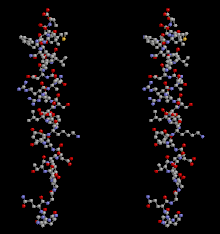Glucagon (medication)

|
|
| Clinical data | |
|---|---|
| Trade names | GlucaGen, others |
| AHFS/Drugs.com | Monograph |
| Pregnancy category |
|
| Routes of administration |
IV, IM, subQ |
| ATC code | |
| Identifiers | |
|
|
| CAS Number | |
| PubChem CID | |
| IUPHAR/BPS | |
| ChemSpider | |
| UNII | |
| ChEMBL | |
| Chemical and physical data | |
| Formula | C153H225N43O49S |
| Molar mass | 3482.747314 g/mol |
| 3D model (Jmol) | |
|
|
|
|
|
|
|
Glucagon is a medication and hormone. As a medication it is used to treat low blood sugar, beta blocker overdose, calcium channel blocker overdose, and those with anaphylaxis who do not improve with epinephrine. It is given by injection into a vein, muscle, or under the skin.
Common side effects include vomiting. Other side effects include low blood potassium and low blood pressure. It is not recommended in people who have a pheochromocytoma or insulinoma. Use in pregnancy has not be found to be harmful to the baby. Glucagon is in the glycogenolytic family of medications. It works by causing the liver to break down glycogen into glucose.
Glucagon was approved for medical use in the United States in 1960. It is on the World Health Organization's List of Essential Medicines, the most effective and safe medicines needed in a health system. The wholesale cost in the developing world is about 25.75 USD a dose. In the United Kingdom that dose costs the NHS about 11.52 pounds. In the United States the wholesale cost of a dose is 247.32 USD. It is a manufactured form of the glucagon hormone.
...
Wikipedia
